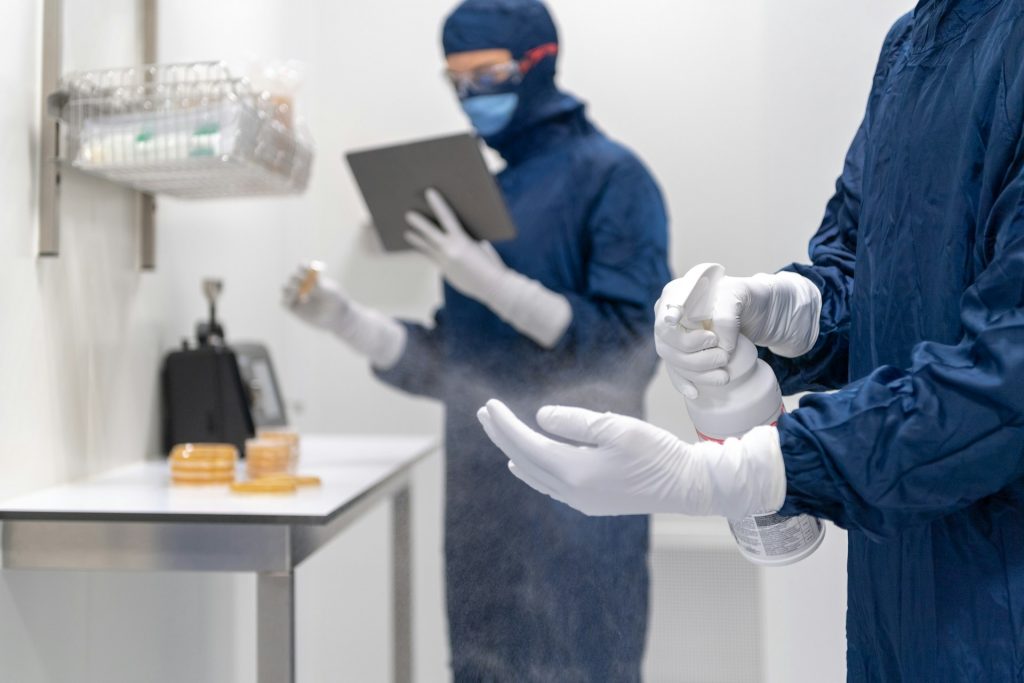Don’t leave bacteria and germs behind. Find out the optimal contact time for low level disinfection wipes to effectively clean surfaces with this helpful guide.
Infection control is an important aspect of maintaining a clean and safe environment, especially in high traffic areas such as hospitals, schools, and offices. Disinfecting wipes are a popular choice for quick and easy cleaning, but it’s important to understand the contact time necessary for effective use. Contact time refers to the amount of time a surface must remain wet with a disinfectant in order to effectively kill bacteria and germs. This ensures that the disinfectant has enough time to work and properly eliminate any harmful microorganisms on the surface.
What Is Contact Time And Why It Matters For Disinfection
Contact time refers to the period a disinfectant must stay in contact with a surface to effectively eliminate pathogens. It plays a pivotal role in disinfection by ensuring thorough pathogen eradication and preventing the spread of infections. Adequate contact time allows the disinfectant to penetrate and act upon the microorganisms present on the surface, effectively neutralizing them. Insufficient contact time can compromise the disinfection process, leaving behind viable pathogens and increasing the risk of transmission. Thus, understanding and adhering to the specified contact time is crucial for achieving optimal disinfection outcomes and maintaining a safe environment.
What’s The Difference Between High-Level Disinfectant & Low-Level Disinfectant?
High-level disinfectants and low-level disinfectants serve distinct roles in infection control, differing in their potency, spectrum of activity, and recommended applications. High-level disinfectants are potent chemicals capable of eliminating a broad range of pathogens, including bacteria, viruses, fungi, and spores. They are typically employed for sterilizing medical instruments and surfaces that come into contact with mucous membranes or sterile tissues. Examples include hydrogen peroxide, peracetic acid, and glutaraldehyde. Conversely, low-level disinfectants are less potent and primarily target vegetative bacteria and some viruses. They are suitable for disinfecting non-critical surfaces and equipment. Common low-level disinfectants include quaternary ammonium compounds, alcohol-based solutions, and phenolic compounds. The choice between high-level and low-level disinfectants depends on the specific disinfection requirements, level of pathogen contamination, and surface/material compatibility.
Optimal Contact Time For Low Level Disinfection Wipes
The recommended contact times for low-level disinfection wipes vary depending on the types of pathogens targeted and the environment being treated. Generally, for common bacteria such as Staphylococcus aureus and Escherichia coli, contact times of 1 to 2 minutes are often sufficient. However, for more resilient viruses like norovirus or influenza, longer contact times of 5 to 10 minutes may be necessary to ensure effective disinfection. Factors influencing optimal contact time include the type of surface (porous vs. non-porous), level of contamination, and the formulation of the disinfectant. Porous surfaces may require longer contact times for penetration, while disinfectants with enhanced formulations may offer quicker action. It’s crucial to adhere to manufacturer instructions for each specific disinfectant wipe to ensure efficacy.
Factors Affecting Contact Time For Disinfection Wipes
Factors affecting contact time for disinfection wipes include the type and concentration of the active ingredients, the presence of organic matter or biofilm on surfaces, surface texture, and temperature. Additionally, the level of pathogen contamination and adherence to proper application techniques can influence the efficacy of contact time.
Surface Material And Texture
Surface material and texture impact the ability of disinfectant wipes to maintain contact and distribute active ingredients. Porous or rough surfaces, like fabrics or textured plastics, may impede contact and absorption, requiring longer contact times for effective disinfection. Examples include upholstery, carpets, and textured countertops, which may necessitate extended contact for thorough disinfection.
Pathogen Susceptibility
The susceptibility of pathogens influences the required contact time for disinfection wipes. Certain pathogens, like enveloped viruses or vegetative bacteria, are more easily eradicated and may require shorter contact times. However, more resilient pathogens such as non-enveloped viruses (e.g., norovirus), bacterial spores (e.g., Clostridium difficile), or mycobacteria may necessitate extended contact times for effective eradication due to their protective structures or resistance mechanisms.
Disinfectant Formulation
The composition of disinfectant solutions, including active ingredients and concentration, significantly affects the required contact time. Higher concentrations or more potent active ingredients may allow for shorter contact times, while lower concentrations may require longer durations for efficacy. It’s crucial to use disinfectant wipes formulated to target specific pathogens, ensuring they contain appropriate concentrations of active ingredients tailored to the pathogens of concern. This ensures optimal disinfection efficacy while minimizing contact time requirements.
Environmental Conditions
Environmental conditions like temperature and humidity can influence disinfectant efficacy and contact time. Higher temperatures can enhance disinfection, while high humidity may hinder drying and efficacy. Adjust contact times accordingly to maintain consistent disinfection outcomes. Monitor environmental factors to optimize disinfection effectiveness and ensure reliable pathogen eradication.
Compliance With Manufacturer Instructions
Adhering to manufacturer instructions on contact time for disinfection wipes is crucial for optimal results. Follow guidelines precisely to ensure effective pathogen eradication. Verify recommended contact times on product labels or packaging, and use timers or alarms to track application duration accurately. Consistent compliance with manufacturer instructions ensures reliable disinfection outcomes and minimizes the risk of incomplete pathogen elimination.
Choosing The Right Disinfection Wipes With Appropriate Contact Time
When choosing disinfection wipes, consider their intended use, surface compatibility, and efficacy against targeted pathogens. Assess product labels for information on active ingredients, concentrations, and recommended contact times. Ensure the wipes are suitable for the surfaces and pathogens you aim to disinfect. Look for wipes with clear instructions matching your disinfection needs, promoting effective pathogen eradication within the specified contact time.
Proper Usage And Instructions For Maximizing Contact Time
Following manufacturer instructions for proper usage and contact time is crucial for maximizing disinfection efficacy. Deviating from these guidelines may result in insufficient contact time, compromising the effectiveness of the disinfection process and leaving behind harmful pathogens. Thus, adherence to manufacturer instructions ensures thorough pathogen eradication and promotes a safe and hygienic environment.
Understanding Manufacturer Guidelines
Following manufacturer instructions for disinfection wipes is essential, as they dictate proper usage and contact time, ensuring effective pathogen eradication. Locate instructions on product labels or packaging, focusing on active ingredients, concentration, and recommended contact times. Adhering to these guidelines guarantees optimal disinfection outcomes and maintains a safe environment.
Application Techniques For Maximizing Contact Time
- Begin by wearing appropriate personal protective equipment (PPE), such as gloves.
- Remove one disinfection wipe from the container or packaging.
- Unfold the wipe fully to expose the entire surface area.
- Start wiping the surface from one corner, moving in a back-and-forth motion.
- Ensure thorough coverage by overlapping each wipe pass slightly.
- Pay special attention to high-touch areas and areas prone to contamination.
- Maintain consistent pressure while wiping to promote contact between the disinfectant and the surface.
- Allow the disinfectant solution to dwell on the surface for the recommended contact time specified by the manufacturer.
- If necessary, use multiple wipes to cover larger surfaces or ensure adequate saturation.
- After the dwell time has elapsed, allow the surface to air dry or use a clean cloth to dry if required.
- Dispose of used wipes properly according to manufacturer or local guidelines.
- Wash hands thoroughly after completing the disinfection process.
Following these steps ensures effective application of disinfection wipes, maximizes contact time and promotes thorough pathogen eradication.
Factors Affecting Contact Time Compliance
Common challenges to contact time compliance include large surface areas, limited accessibility, and time constraints. To overcome these barriers, prioritize high-touch surfaces, use pre-saturated wipes for convenience, and allocate sufficient time for thorough disinfection. Implementing clear protocols, providing adequate training, and using disinfection products with shorter contact times can also facilitate compliance.
Monitoring And Verification Of Contact Time
Monitoring and verifying contact time during disinfection is vital for ensuring efficacy. Utilize timers to track application duration accurately. Visual indicators on some wipes change color upon completion of contact time. Test strips can confirm disinfectant concentration and effectiveness. Regular inspection and quality assurance measures reinforce compliance, guaranteeing thorough pathogen eradication and maintaining a safe environment.
Get The Expert Disinfection Services Today!
In today’s ever-evolving world, maintaining consistent and effective disinfection practices is paramount. Green Clean Janitorial offers expert disinfection services tailored to meet the unique needs of businesses. With our commitment to cleanliness and sustainability, we provide eco-friendly solutions that ensure thorough pathogen eradication while minimizing environmental impact. Let us help you create a safer and healthier environment for your employees and customers. Choose Green Clean Janitorial for reliable, professional, and environmentally conscious disinfection services. Schedule your appointment today and experience the difference firsthand!
The decision depends on the specific pathogens present, the level of contamination, the surface material, and the intended use. High-level disinfectants are typically reserved for critical medical instruments or surfaces where there is a high risk of infection transmission, while low-level disinfectants are suitable for general environmental surfaces and non-critical medical devices.
The frequency of use depends on factors such as foot traffic, surface contamination, and the presence of pathogens. Generally, high-touch surfaces should be disinfected more frequently.
Yes, insufficient contact time can result in incomplete disinfection, leaving behind pathogens that may pose a risk to health. It’s essential to adhere to the recommended contact times for maximum efficacy.




